#18th-century history
Explore tagged Tumblr posts
Text


Now with links to the books added! I sent the files to press for ECF July 2024, so you know what that means: The July issue reviews section is free to read on the journal website -- ecf.humanities.mcmaster.ca/bookreviews/
#18thCentury Get your read on!
ECF 36.3 Book titles, authors, publishers, reviewers; ToC titles, etc.
England Re-Oriented: How Central and South Asian Travelers Imagined the West, 1750–1857 by Humberto Garcia
Review by Eun Kyung Min, Seoul National University
Literary Authority: An Eighteenth-Century Genealogy by Claude Willan
Review by Paul Keen, Carleton University
Backlash: Libel, Impeachment, and Populism in the Reign of Queen Anne by Rachel Carnell
Review by Nicola Parsons, University of Sydney
Death and the Body in the Eighteenth-Century Novel by Jolene Zigarovich
Review by Heather Meek, Université de Montréal
Daniel Defoe in Context, ed. Albert J. Rivero and George Justice
Review by Kit Kincade, Indiana State University
Women and Property Ownership in Jane Austen by Rita J. Dashwood
Review by Lise Gaston, Concordia University
Romantic Fiction and Literary Excess in the Minerva Press Era by Hannah Doherty Hudson
Review by Elizabeth Neiman, University of Maine
Romanticism and the Biopolitics of Modern War Writing by Neil Ramsey
Review by Matthew Reznicek, University of Minnesota
Decoding Anne Lister: From the Archives to “Gentleman Jack,” ed. Chris Roulston and Caroline Gonda
Review by Ula Lukszo Klein, University of Wisconsin Oshkosh
Theology in the Early British and Irish Gothic, 1764–1834 by Sam Hirst Review by Jarlath Killeen, Trinity College Dublin
#eighteenth-century fiction#18th-century literature#18th century#18th-century novels#18th-century history#eighteenth century
6 notes
·
View notes
Text

The beautiful French frigate L'Hermione from 1780, sailing in line astern behind a modern French Aquitaine class frigate Provence, 2015
#tall ship#naval history#french frigate#l'hermione#Provence#18th century#21st century#age of sail replica#modern frigate#happy frigate friday#c'mon granny let me help you
10K notes
·
View notes
Text
I was about to be irritated at a shitty "kids' education" website on 1770s clothing but then I learned that there's a staymaker buried at King's Chapel and now I'm just delighted to know the gravesite of a clothing worker from that era and I want to take him flowers
16K notes
·
View notes
Text
On the road leading into the center of Concord, Massachusetts, there sits a house.

It is a plain, colonial-style house, of which there are many along this road. It has sea green and buff paint, a historical plaque, and one of the most multi-layered stories I have ever encountered to showcase that history is continuous, complicated, and most importantly, fragmentary, unless you know where to look.
So, where to start? The plaque.

There's some usual information here: Benjamin Barron built the house in 1716, and years later it was a "witness house" to the start of the American Revolution. And then, something unusual: a note about an enslaved man named John Jack whose epitaph is "world famous."
Where is this epitaph? Right around the corner in the town center.
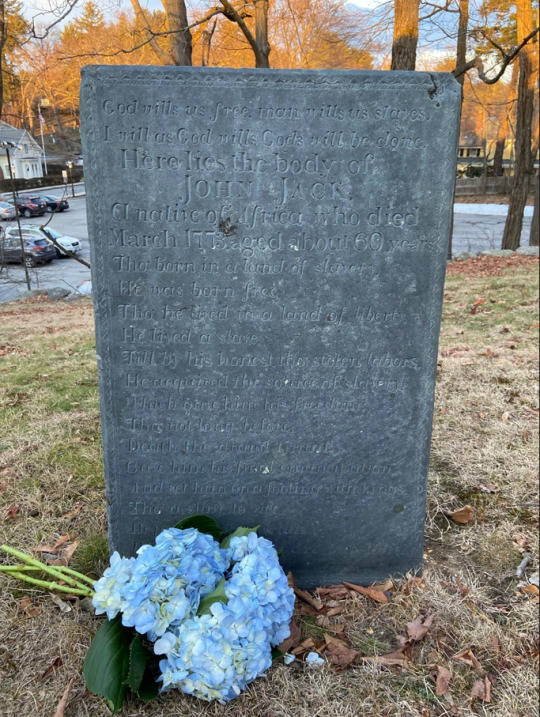
It reads:
God wills us free; man wills us slaves. I will as God wills; God’s will be done. Here lies the body of JOHN JACK a native of Africa who died March 1773 aged about 60 years Tho’ born in a land of slavery, He was born free. Tho’ he lived in a land of liberty, He lived a slave. Till by his honest, tho’ stolen labors, He acquired the source of slavery, Which gave him his freedom; Tho’ not long before Death, the grand tyrant Gave him his final emancipation, And set him on a footing with kings. Tho’ a slave to vice, He practised those virtues Without which kings are but slaves.
We don't know precisely when the man first known only as Jack was purchased by Benjamin Barron. We do know that he, along with an enslaved woman named Violet, were listed in Barron's estate upon his death in 1754. Assuming his gravestone is accurate, at that time Jack would have been about 40 and had apparently learned the shoemaking trade from his enslaver. With his "honest, though stolen labors" he was then able to earn enough money to eventually purchase his freedom from the remaining Barron family and change his name to John, keeping Jack as a last name rather than using his enslaver's.
John Jack died, poor but free, in 1773, just two years before the Revolutionary War started. Presumably as part of setting up his own estate, he became a client of local lawyer Daniel Bliss, brother-in-law to the minister, William Emerson. Bliss and Emerson were in a massive family feud that spilled into the rest of the town, as Bliss was notoriously loyal to the crown, eventually letting British soldiers stay in his home and giving them information about Patriot activities.
Daniel Bliss also had abolitionist leanings. And after hearing John's story, he was angry.
Here was a man who had been kidnapped from his home country, dragged across the ocean, and treated as an animal for decades. Countless others were being brutalized in the same way, in the same town that claimed to love liberty and freedom. Reverend Emerson railed against the British government from the pulpit, and he himself was an enslaver.
It wouldn't do. John Jack deserved so much more. So, when he died, Bliss personally paid for a large gravestone and wrote its epitaph to blast the town's hypocrisy from the top of Burial Hill. When the British soldiers trudged through the cemetery on April 19th, 1775, they were so struck that they wrote the words down and published them in the British newspapers, and that hypocrisy passed around Europe as well. And the stone is still there today.

You know whose stone doesn't survive in the burial ground?
Benjamin Barron's.
Or any of his family that I know of. Which is absolutely astonishing, because this story is about to get even more complicated.
Benjamin Barron was a middle-class shoemaker in a suburb that wouldn't become famous until decades after his death. He lived a simple life only made possible by chattel slavery, and he will never show up in a U.S. history textbook.
But he had a wife, and a family. His widow, Betty Barron, from whom John purchased his freedom, whose name does not appear on her home's plaque or anywhere else in town, does appear either by name or in passing in every single one of those textbooks.
Terrible colonial spelling of all names in their marriage record aside, you may have heard her maiden name before:

Betty Parris was born into a slaveholding family in 1683, in a time when it was fairly common for not only Black, but also Indigenous people to be enslaved. It was also a time of war, religious extremism, and severe paranoia in a pre-scientific frontier. And so it was that at the age of nine, Betty pointed a finger at the Arawak woman enslaved in her Salem home, named Titibe, and accused her of witchcraft.
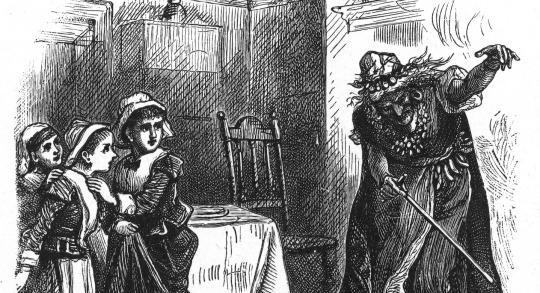
Yes, that Betty Parris.
Her accusations may have started the Salem Witch trials, but unlike her peers, she did not stay in the action for long. As a minor, she was not allowed to testify at court, and as the minister's daughter, she was too high-profile to be allowed near the courtroom circus. Betty's parents sent her to live with relatives during the proceedings, at which point her "bewitchment" was cured, though we're still unsure if she had psychosomatic problems solved by being away from stress, if she stopped because the public stopped listening, or if she stopped because she no longer had adults prompting her.
Following the witch hysteria, the Parrises moved several times as her infamous father struggled to hold down a job and deal with his family's reputation. Eventually they landed in Concord, where Betty met Benjamin and married him at the age of 26, presumably having had no more encounters with Satan in the preceding seventeen years. She lived an undocumented life and died, obscure and forgotten, in 1760, just five years before the Stamp Act crisis plunged America into a revolution, a living bridge between the old world and the new.
I often wonder how much Betty's story followed her throughout her life. People must have talked. Did they whisper in the town square, "Do you know what she did when she was a girl?" Did John Jack hear the stories of how she had previously treated the enslaved people in her life? Did that hasten his desperation to get out? And what of Daniel Bliss; did he know this history as well, seeing the double indignity of it all? Did he stop and think about how much in the world had changed in less than a century since his neighbor was born?
We'll never know.
All that's left is a gravestone, and a house with an insufficient plaque.
7K notes
·
View notes
Text
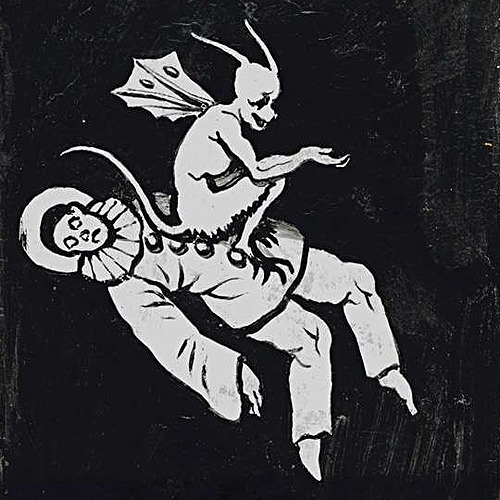

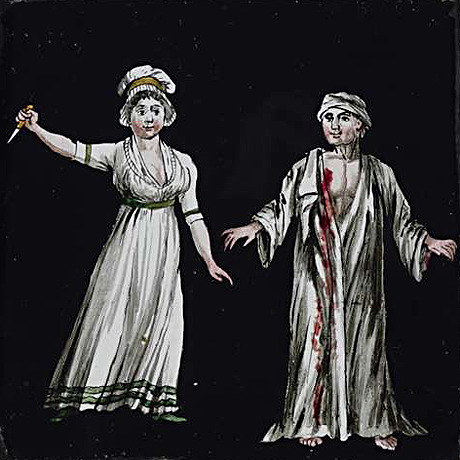






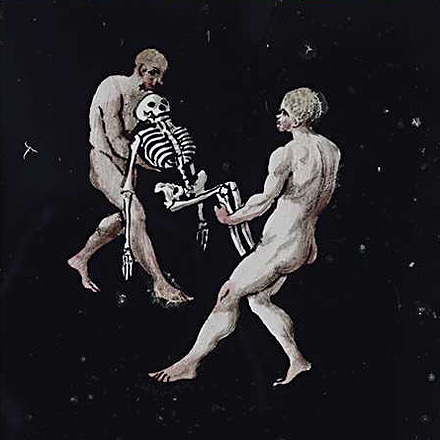
Magic lantern slides (ca.1700 - ca.1830)
6K notes
·
View notes
Text
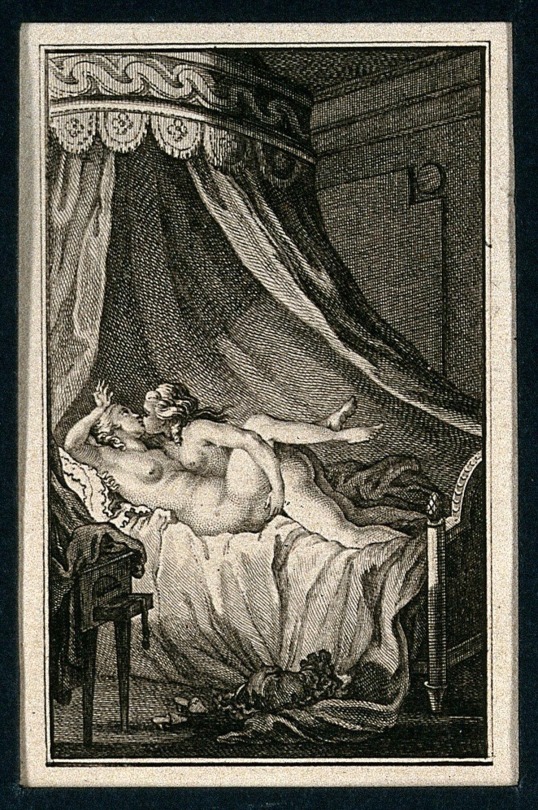
Two Women Engaged in Sexual Intercourse in a Neoclassical Canopied Bed. Etching, ca. 1780. via JSTOR
20K notes
·
View notes
Text
Today I found out that that alleged 18th Century woodcut of a woman saying "come out you bitch, I'll maul you" that's been doing the rounds is apparently 100% legitimate, and the reason nobody could source it is because the screenshot gets the title wrong. It's evidently from The new art and mystery of gossiping (the popularly circulated screenshot misspells "mystery" as "mastery"), and the full text is available here:
14K notes
·
View notes
Text

Barn Owls with Their Brood, William Tomkins, ca. 1775
#art#art history#William Tomkins#genre painting#genre art#animals in art#owl#owls#barn owl#barn owls#British art#English art#18th century art#oil on canvas#National Trust
2K notes
·
View notes
Text


Alessandro Magnasco (Italian, 1667–1749), "Landscape with Shepherds" (details). São Paulo Museum of Art.
#Alessandro Magnasco#art#italian art#painting#landscape#mountain#mountains#sheperds#oil painting#17th century#18th century#17th century art#18th century art#paintings#art detail#art history#aesthetic#baroque#nature#scenery
809 notes
·
View notes
Text
Reblog game based on the 3 viable career paths available to clever commoners in the 18th century
#reblog game#tag game#poll#mutuals#18th century#1700s#history#history memes#prev game#frev#frev memes#frev community#french revolution
1K notes
·
View notes
Text
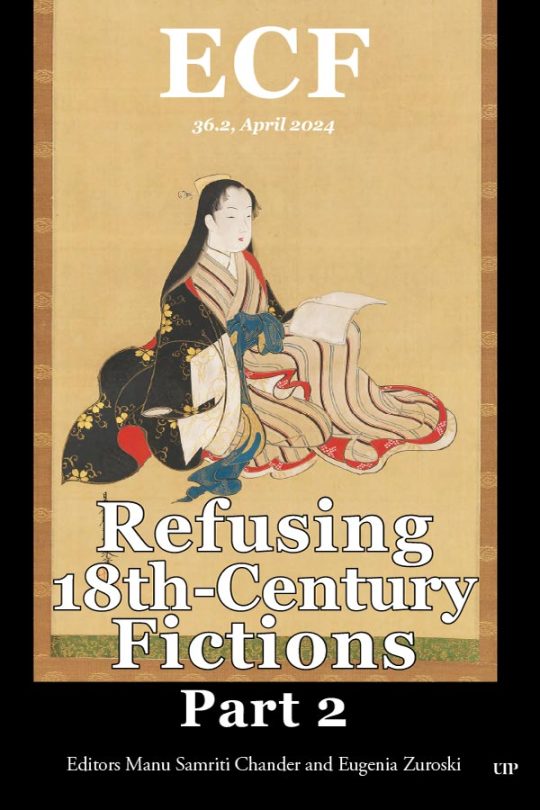
Great news for a Tuesday! The new ECF special issue "Refusing 18th-Century Fictions, Part 2" is now available to read at Project MUSE:
https://muse.jhu.edu/issue/52266
#18thCentury #ASECS2024 #asecs24
Cover caption: The image on the front cover is Young Woman with a Book, by Miyagawa (Katsukawa) Shunsui (mid-18th century). The digital file of this Public Domain painting is provided courtesy of The Met, New York.
#eighteenth-century fiction#18th-century art#18th century#18th-century literature#18th-century portrait#18th-century novels#18th-century history
2 notes
·
View notes
Text


Coat
c. 1770-1799
The National Museum of Norway
#1770s#1780s#1790s#menswear#red#18th century#18th century fashion#historical fashion#historical clothing#fashion history#history of fashion#coat#frostedmagnolias
692 notes
·
View notes
Text
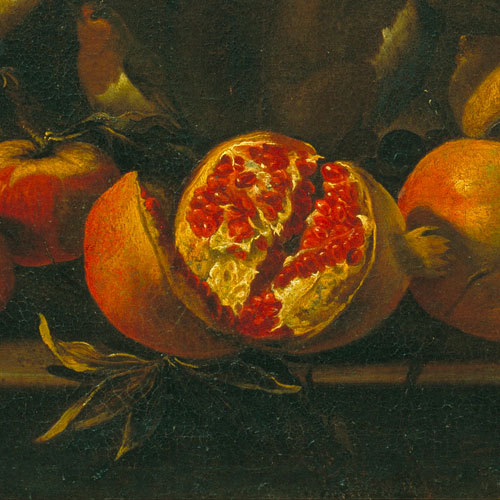




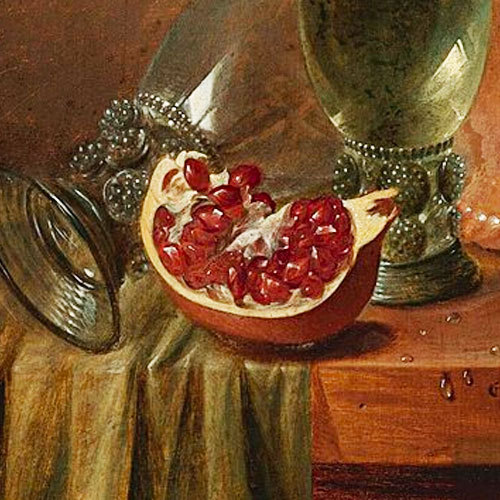



pomegranates in still life (details)
#oil painting#art#still life#still life details#pomegranate#17th century art#18th century art#fruit art#art details#art history#artedit#light academia#dark academia#light academia moodboard#anna attempts photoshop#1k+#5k+#7k
7K notes
·
View notes
Text

Soap Bubbles, probably 1733-1734 Jean-Baptiste-Siméon Chardin
#Jean-Baptiste-Siméon Chardin#french art#Soap Bubbles#happiness#art#painting#art history#portrait#1730s#18th century
1K notes
·
View notes
Text
Glossary of Nautical Terms - as used in the late 18th and early 19th centuries

Aft: at or towards the stern or after part of a ship, the opposite of bow.
Aloft: overhead, or above.
Athwart: across.
Bank: a rising ground in the sea, differing from a shoal, because not rocky but composed of sand, mud or gravel.
Becalmed: to halt through lack of wind.
Bow: the foremost end or part of a ship, the opposite of stern.
Bowsprit: a large mast or piece of timber which stands out from the bow of a ship.
Burthen: the older term used to express a ship's tonnage or carrying capacity. It was based on the number of tuns of wine that a ship could carry in her holds, the total number giving her burthen.
Chase, to: to pursue a vessel in wartime with the aim of capturing, acquiring information from her, or destroying.
Colours: the name by which the national flag flown by a ship at sea is known, used to determine nationality.
Dead reckoning: a system of navigation where the position of a ship is calculated without the use of any astronomical observation whatever.
Fair wind: a wind favourable to the direction a ship is sailing.
Fathom: a measure of six feet, used to divide the lead (or sounding) lines in measuring the depth of water; and to calculate in the length of cables, rigging, etc.
Fore: the forward part.
Hail, to: to call to another ship.
Helm: the instrument by which the ship is steered, and includes both the wheel and the tiller, as one general term.
Jib: a triangular sail set by sailing ships on the boom which runs out from the bowsprit.
Jury-mast: a temporary makeshift mast erected to replace a mast that has been disabled or carried away.
Jury-rudder: a makeshift arrangement to give a ship the ability to to steer when she has lost her rudder.
Keel: the lowest and principal timber of a wooden ship - the single strongest member of the ship's frame.
Knot: the nautical measure of speed, one knot being a speed of one nautical mile (6,080 feet) per hour. As a measure of speed the term is always knots, and never knots an hour.
Landfall: the discovery of the land.
Land-locked: sheltered all round by the land, so that there is no view of the sea.
Lead: an instrument for discovering the depth of water, attached to a lead-line, which is marked at certain distances to measure the fathoms.
Lee: the side of a ship, promontory, or other object away from the wind; that side sheltered from the wind. It is the opposite side to windward.
Lee shore: a coastline on to which the wind blows directly - consequently it can be dangerous as the wind tends to force the sailing ship down on it.
Leeward: with the wind; towards the point to which the wind blows.
Letter of Marque: a commission issued in Britain by the Lord High Admiral or Commissioners of the Admiralty authorizing the commander of a privately owned ship to cruise in search of enemy merchant vessels. The letter of marque described the ship, her owners and officers, the amount of surety which had been deposited and stressed the necessity of having all prize vessels or goods seized condemned and valued at a Vice Admiralty Court for the payment of 'prize money'.
Lie-to: to prevent a vessel from making progress through the water - achieved by reducing sail in a gale. The objective is to keep the vessel in such a position, with the wind on the bow, as to ensure that heavy seas do not break aboard.
The Line (or 'Crossing the Line') Sailing across the Equator. Nautical tradition where seamen celebrate the crossing of the equator by dressing up and acting out a visit by King Neptune. Those who have not previously crossed the line are summoned to the court of Neptune for trial, followed by a ritual ducking (in a bathing tub of seawater) and sometimes lathered and roughly shaved.
Mainsail: the principal sail of a sailing vessel.
Mizzen (or mizen): the name for the third, aftermost, mast of a square-rigged sailing ship or of a three-masted schooner.
Muster: to assemble the crew of a ship on deck and call through the list of names to establish who is present and accounted for.
Muster-book: the book kept on board a vessel in which was entered the names of all men serving in the ship, with the dates of their entry and final discharge from the crew. It was the basis on which victuals were issued and payment made for services performed on board.
Pintle: a vertical metal pin attached to the leading edge of the rudder; it is fitted into the metal ring or 'gudgeon' bolted to the sternpost of a vessel. This provides the means for hinging the rudder on the sternpost and allows a rudder to be swung or turned as desired (by use of the tiller); where necessary (ie. when the rudder needs to be removed or repaired) the pintles can be unshipped quickly and the rudder detached.
Port: the left-hand side of a vessel as seen from the stern; also a harbour or haven.
Privateer: a privately owned vessel armed with guns which operated in time of war against the trading vessels of an enemy nation. Each privateer was given a a 'letter of marque' which was regarded as a commission to seize any enemy shipping as a 'prize'. The name 'privateer' has come to refer to both the ship and the men who sailed in her.
Prize: name used to describe an enemy vessel captured at sea by a ship of war or a privateer; also used to describe a contraband cargo taken from a merchant ship. A 'prize court' would then determine the validity of capture of ships and goods and authorize their disposal. 'Prize' in British naval history always acted as considerable incentive to recruitment with many men tempted to join the navy in anticipation of quick riches.
Prize Court: Captured ships were to be brought before prize courts where it was decided whether the vessel was legal prize; if so, the whole value was divided among the owners and the crew of the ship.
Prize Money: the net proceeds of the sale of enemy shipping and property captured at sea - these proceeds were distributed to the captors on a sliding scale from highest rank to lowest seaman.
Road or Roadstead: a stretch of sheltered water near land where ships may ride at anchor in all but very heavy weather; often rendered as 'roads', and does not refer to the streets of a particular port city but rather its anchorage, as in 'St Helens Roads', the designated anchorage for shipping located between St. Helens (Isle of Wight) and Portsmouth, or 'Funchal Roads' at the island of Madeira. (see Elizabeth Macquarie's 1809 Journal).
Quarter: (1)the direction from which the wind was blowing, particularly if it looked like remaining there for some time; (2)the two after parts of the ship - strictly speaking a ship's port or starbord quarter was a bearing 45° from the stern.
Ship: from the Old English scip, the generic name for sea-going vessels (as opposed to boats). Originally ships were personified as masculine but by the sixteenth century almost universally expressed as as feminine.
Shoal: a bank or reef, an area of shallow water dangerous to navigation. Sounding: the of operation of determioning the depth of the sea, and the quality of the ground, by means of a lead and line, sunk from the ship to the bottom, where some of the sediment or sand adheres to the tallow in the hollow base of the lead.
Sound: (1) to try the depth of the water; (2) a deep bay.
Sounding: ascertaining the depth of the sea by means of a lead and line, sunk from a ship to the bottom.
Soundings: those parts of the ocean not far from the shore where the depth is about 80 to 100 fathoms.
Spar: a general term for any wooden support used in the rigging of a ship - includes all masts, yards, booms, gaffs etc.
Squall: a sudden gust of wind of considerable strength.
Starboard: the right-hand side of a vessel as seen from the stern.
Stern: after-part of a ship or boat.
Tack: the nautical manouevre of bringing a sailing vessel on to another bearing by bringing the wind round the bow; during this manouevre the vessel is said to be 'coming about'.
Tide of Flood: the flow of the tidal stream as it rises from the ending of the period of slack water at low tide to the start of the period of slack water at high tide; its period is approximately six hours.
Trade Winds: steady regular winds that blow in a belt approximately 30 N. and 30 S of the equator. In the North Atlantic the trades blow consistently all year round, from the north-east; in the South Atlantic they blow from the south-east, converging just north of the equator. The meeting of the trade winds just north of the equator created the infamous 'doldrums', where sailing ships could be becalmed for days or weeks waiting for a wind to carry them back into the trades.They were known as trade winds because of their regularity, thereby assisting sailing vessels in reaching their markets to carry out trade.
Under way: the description of a ship as soon as she begins to move under canvas power after her anchor has been raised from the bottom; also written as 'under weigh.'
Voyage: a journey by sea. It usually includes the outward and homeward trips, which are called passages.
Watch: (1) one of the seven divisions of the nautical day; (2) one of two divisions of the seamen forming the ship's company.
Wear: the nautical manouevre of bringing a sailing vessel on to another tack by bringing the wind around the stern.
Weather: in a nautical sense (rather than a meteorological) this is the phrase used by seamen to describe anything that lies to windward. Consequently, a coastline that lies to windward of a ship is a weather shore; the side of a ship that faces the wind when it is under way is said to be the weather side a ship, etc.
Weigh: to haul up.
Weigh anchor: the raising of the anchor so that the ship is no longer secured to the sea or river bottom.
Windward: the weather side, or that direction from which the wind blows. It is the opposite side to leeward.
Yard: (1) a large wooden spar crossing the masts of a sailing ship horizontally or diagonally, from which a sail is set. (2) a shortened form of the word 'dockyard, in which vessels are built or repaired.
Sources: JEANS, Peter D. Ship to Shore: a dictionary of everyday words and phrases derived from the sea. Santa Barbara: ABC-Clio, 1993.
The Oxford Companion to Ships & the Sea. (ed.) Peter Kemp. Oxford: Oxford University Press, 1976.
#naval history#naval artifacts#ship terms#not from me#sources below#18th century#19th century#age of sail#infos
2K notes
·
View notes
Text


▪︎ Calliope.
Date: ca. 1763
Artists: Augustin Pajou (French, 1730 - 1809)
Medium: Marble
#18th century#art#history#18th century art#decorative arts#history of art#sculpture#statue#calliope#Agustin Pajou#marble#ca. 1763
518 notes
·
View notes